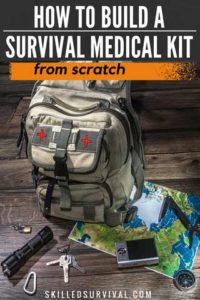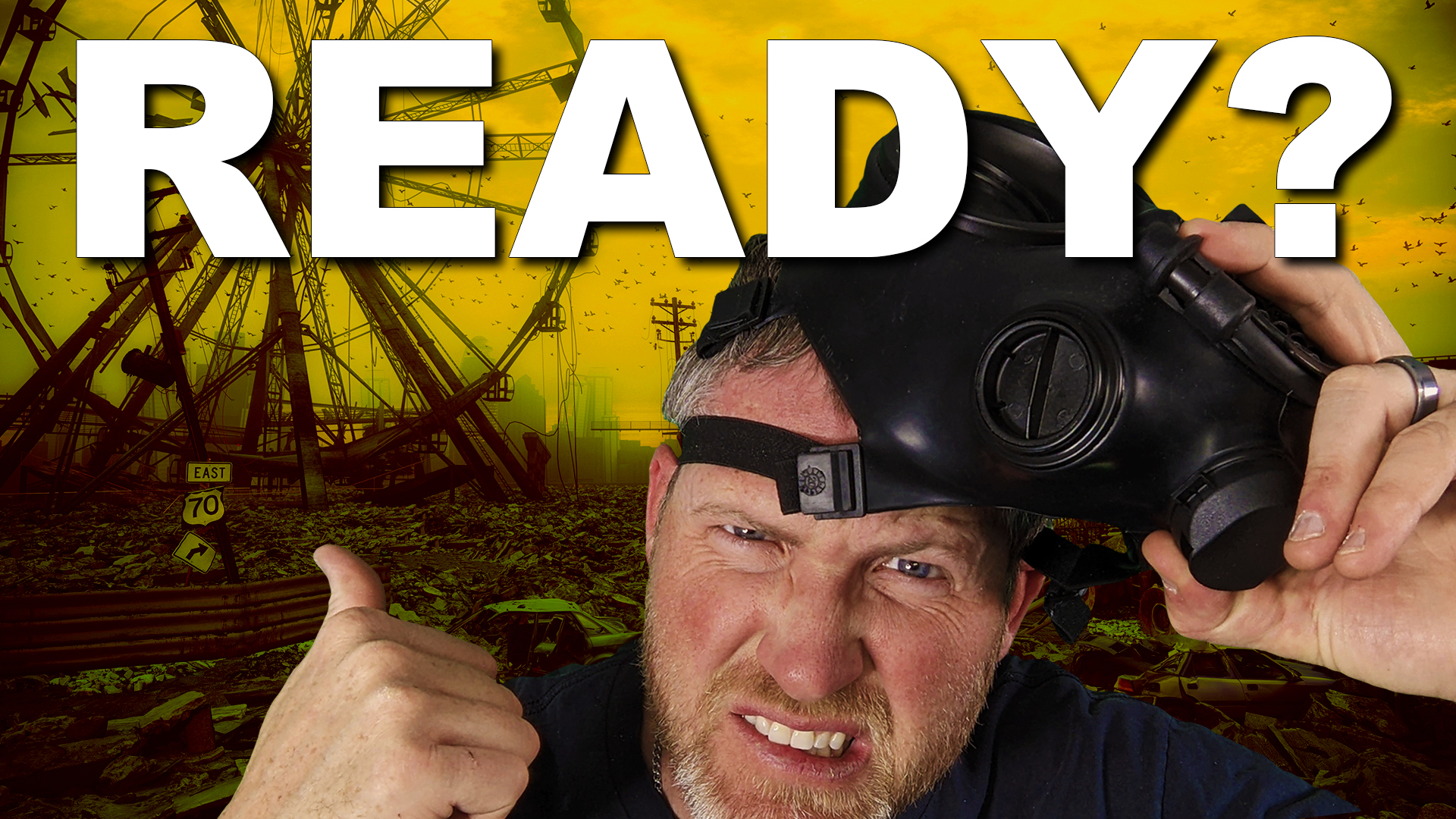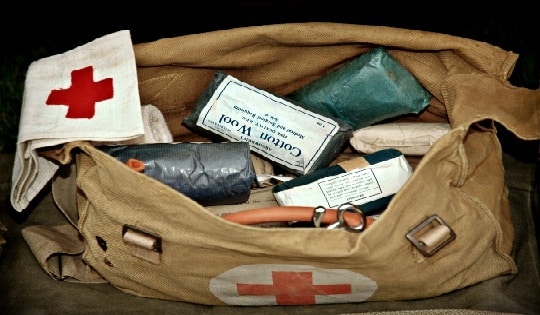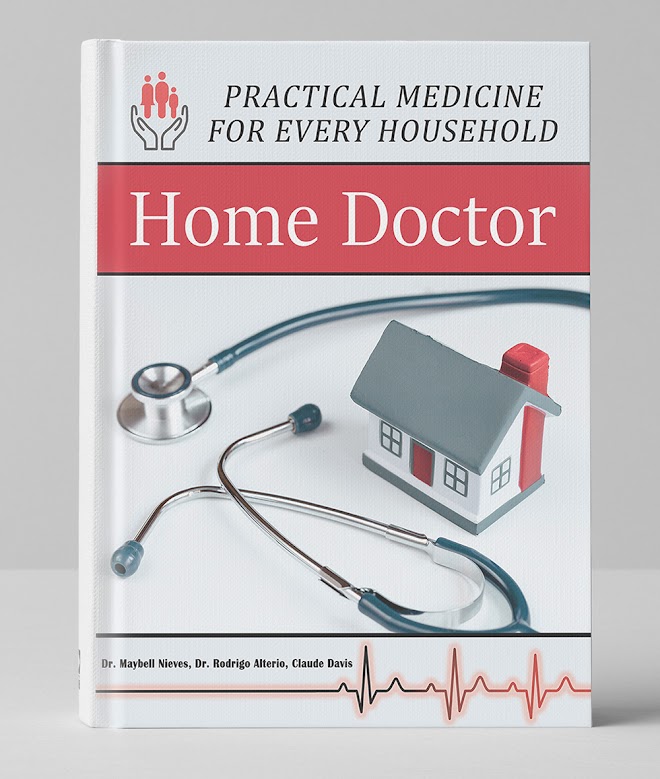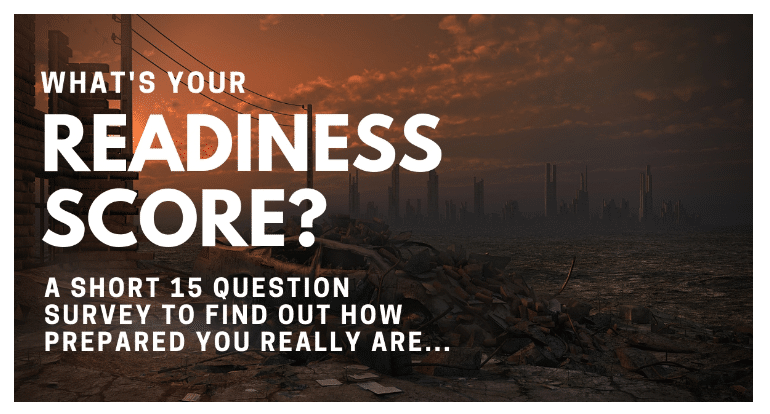Step By Step Guide To Building A Survival First Aid Kit
Call it what you like:
- Medical Kit
- DIY First Aid Kit
- Survival Medical Kit
The specific name doesn’t matter.
What matters is you have one in a time of need.
One ready to go at a moment’s notice!
Ready when misadventure strikes.
Because if you’re unprepared for a medical emergency, things can quickly go from bad to worse.
Having a functional medical kit is essential for survival.
That’s why everyone needs to build or buy one.
Ask any search and rescue team member what you can do today to save yourself or others in a serious medical emergency.
They’ll tell you to:
- Carry a first-aid kit
- Learn how to use it
They also know that good medical first-aid kits are hard to come by.
But fear not! You’ve come to the right place.
This Survival Medical Kit Guide is here to solve that problem.
Specifically, I’ll be using my Engineering, Gear Testing background & my years in Mountian SAR to cover the following topics in detail:
TABLE OF CONTENTS
Best Survival First Aid Kits For Sale
How To Build A Medical Kit
Survival First Aid Kit List
Kit Packing & Storage Strategies
Survival First Aid Skills
Are You Ready For The Tough Times Ahead? Take My 60 Sec Quiz To See If You’re Part Of ‘The Fragile Masses’ Or Not… Start Quiz Now!
Best Survival First Aid Kits On The Market Today
High-quality first aid kits can be hard to find at the right price, especially for the really great ones.
But we’ve done a ton of research to find them anyways.
You can purchase one and then customize it by adding extras and personals.
This is a very efficient and hassle-free way to build one fast.
Here are several high-quality, professional kits ready for any survival scenario:
MyMedic First Aid Kits
If you want the best first aid kits money can buy, look no further than MyMedic.
The team at MyMedic has perfected the art of putting together the perfect medical kits – from Solo kits to first aid kits – all the way up to full-fledged Medical Kits.
They’ve even crafted specialty kits for surfing, boating, and firearms with their Boat Medic, Surf Medic, and Range Medic Bags.
Heck, they even have a Pandemic Medic Kit you can buy!
Now, I recommend the MyFAK Kit or the Recon Kit.
Both are light enough to carry around but have all the necessary supplies to tend to most medical emergencies.
And what I like about ALL the MyMedic Kits is how much attention to detail they give to organization and quality.
You won’t find cheap supplies or tools in these bags – meaning they are worth every penny!
Here’s a thorough video review of MyMedic’s (FAK) First Aid Pack:
↓ My Medic IFAK Kit Review ↓
Waterproof Military Cross-body Molle Sling Bag
A military medic backpack is one of the most functional containers for a survival medical kit.
The number of pockets and high durability make them extremely functional options.
This “go anywhere” design is perfect when a larger pack is too big, bulky, and heavy.
This pack can fit many medical tools and supplies but is not so big to become cumbersome.
It can also be worn in 3 configurable ways (across the back, chest, or hand carry).
This is a MOLLE-compatible pouch and has 3 zippered compartments.
It’s the right size, shape, and design to make an excellent portable survival medical kit.
Want a Downloadable and Printable Version Of This Survival Medical Checklist? Click Here To Get Your FREE Copy Of It.
Survival First Aid Kit List
It’s best to start with the basics.
From diarrhea to headaches – from inflammation to small cuts or minor infections…
These basics will be the most frequently used items in your kit.
So they should be the most accessible as well. Make sure to pack extra.
These supplies can be bought at drugstores, pharmacies, or even online.
You’ll have no trouble assembling the contents in the following section.
Basic Medical Tools
Tweezers are a commodity. All tweezers are created equal…
Not even close! Cheap $2 tweezers are not good enough for your medical kit.
Upgrade to these tactical tweezers to easily remove hard-to-get-at splinters and foreign objects.
Non-Contact Infrared Thermometer
You should look for a non-contact infrared forehead thermometer.
You want non-contact if you ever plan to use this in the field, especially during a pandemic.
And you want infrared to make getting a reading as easy and painless as possible, especially if you have small children.
Trust me:
Trying to hold an old-school thermometer under your kid’s tongue, armpit, or rectum is a hassle of the past.
When time is of the essence (and what medical emergency isn’t), you’ll want to get a temperature reading fast. Get a thermometer like this one.
Buy these online for a nice bulk discount.
And it’s worth going with the Anti-Bacterial Q-Tips for an added layer of medical cleanliness.
These high-quality EMT shears feature a coating that provides a non-stick surface for all your emergency cutting needs.
It includes sharp edges and milled serrations for repeatedly cutting through the toughest material.
Surgical Grade Toenail Clippers
These surgical nail clippers can handle even the thickest toenails due to diabetes, psoriasis, or fungus.
They are sharp, ergonomically designed, and made of stainless steel to prevent rusting or corrosion.
They also come with an unconditional lifetime guarantee.
So these are the last pair of toenail clippers you’ll ever buy.
And they’re good enough for medical emergencies.
Because there are some medical tasks where nail clippers are the only tool for the job.
A sharp scalpel and blade will do for basic medical emergencies.
But if you’re looking for something more advanced, get a suture kit.
The price range of stethoscopes is extreme.
It’s hard to believe, but the more advanced ones are several hundred dollars.
But unless you’re an EMT or a physician, a standard stethoscope like this one is all you need.
Over-The-Counter Medications (Recommended numbers included)
Next up is the list of over-the-counter medications your emergency first aid kit should include:
- Ibuprofen, 20+
- Acetaminophen (Tylenol), 15+
- Aspirin, 15+
- Anti-histamine, x10
- Immodium/Loperamide, x10
- Sudafed (or an equivalent), x10
- Throat lozenges, 10+
- Bismuth tabs, x20
- Oral rehydration, x3
- Cranberry extract, x10
- Dramamine, x10
- Stool softener and/or Laxative, x15
Note: If you are uncertain what each does, click the link to find more specific information about each recommendation.
Lotions and Creams
You should add these medical creams to your first aid kit to help keep wounds clean and free from infection, control minor rashes, reduce inflammation, stop fungus growth, etc.
- Antibiotic ointment (Neosporin or equivalent)
- Hydrocortisone
- Miconazole/Anti-fungal
- Anti-Bacterial Bar Soap (for wound cleaning)
Advanced Wound and Trauma Supplies
This is where more advanced survival medical training comes in handy.
Treating wounds is not always a simple ordeal – especially trauma – and it is often a job that is best left to the professionals.
But in a survival situation, you may be responsible for treating these injuries to the best of your ability.
Realistically, no one is prepared for every medical emergency outside of a hospital.
Wounds can be ugly.
Trauma can be horrifying!
But here are some tools that will help prepare you for both:
Blister Treatments:
Wound Treatments (Recommended numbers included):
- Nitrile gloves, 4+ pairs
- Irrigation syringe
- Sterile gauze pads, 5+
- Band-Aids, 20+ (various sizes)
- Alcohol wipes, 15+
- Ace Bandages, x2
- Triangle bandages, x2
- Tegaderm, x2
- Steri-strip or butterfly closures, 3+
- Sam-splint moldable foam splint
- Israeli bandage
- Suture kit
- Iodine
- Tourniquet
Popular Prescription Medication
Individuals seeking to build an advanced kit should consider including some prescription medications.
These drugs require an advanced understanding of medicine to administer.
But if you have access to these supplies and believe you will need them in the field, prepare yourself accordingly:
- Epinephrine 1mg: Treats severe allergic reactions.
- 1ml small syringe with needle
- Ciprofloxacin 500mg: Treats infections also given to individuals exposed to anthrax.
- Azithromycin 500mg: Treats atypical mycobacterial infections and bacterial infections of the heart valve.
- Bactrim d.s. 160/800mg: Treats bacterial infections
- Amoxicillin 500mg: Treats infections or stomach ulcers.
- Flagyl 500/400mg: Treats bacterial infections.
- Fluconazole 100mg: Prevents and treats certain fungal infections.
Misc. Medical Supplies
- Asthma Inhalers: Albuterol is a basic prescription drug for people with difficulty breathing.
- Vitamins: Pack your favorites, or pack them all. Multivitamins are handy for saving both space and weight.
- Epinephrine: Mentioned before in the prescription section. Epinephrine is a medication for severe allergic reactions. It usually requires a certification to administer to another person (except in the case of a life-threatening emergency).
- Small toy or puzzle: Children can be distractions, and in medical emergencies, they can often be a danger to themselves. Keeping a small toy or puzzle to calm a child down or to offer comfort can be as good as any medication for agitation or distress. It can sometimes even work with adults.
- Toiletries: Just a razor, deodorant, a toothbrush, and toothpaste can make a huge difference in survival. Having extra hygiene supplies never hurts.
- Purell
- Sunblock
- Aquamira or other iodine tablets (for water purification)
- Bug repellent
- CPR pocket mask
- Survival lighter and waterproof matches
Want a Downloadable and Printable Version Of This Survival Medical Checklist? Click Here To Get Your FREE Copy Of It.
Medical Kit Packing & Storage Strategies
Keeping an organized kit is equally important as any of the contents.
In a medical pinch, time is of the essence.
Neither patient nor the caretaker can afford to waste any time sifting through a sack full of unlabeled drugs and sterile swabs.
Preparation is everything.
Divide your kit into a few general categories.
There are several ways you might approach this, but one effective example is to separate the contents as follows:
- Trauma
- Prescription medication
- Over-the-counter medication
- Personal supplies
Trauma kits and supplies are typically required in more urgent scenarios.
So, keep them stored in an easily accessible part of your medkit.
Here are several ways to keep these categories separate and organized:
Separate The Compartments
It may be as easy as using the existing compartments of your container (like in a medic backpack or utility box) to separate your categories.
These come in various sizes and colors, making them ideal for color coding and storage.
Most are made from water-resistant material, extremely durable, light, and highly packable.
They are available at almost any outdoor retailer, surplus store, or online.
This works well for those less concerned with their space and weight.
These also come in different sizes, shapes, and colors for storage and color coding.
Additionally, Tupperware is relatively cheap and accessible anywhere with a grocery store.
These are excellent for a variety of functional purposes.
They can be used for arranging and labeling drugs or different sizes of bandages.
Use a Sharpie to label them clearly.
Zip-lock bags are also effective at containing spills so that leaky soap or iodine bottle doesn’t taint the rest of your emergency survival kit.
A good rule of thumb:
Keep it in a zip-lock bag if it leaks.
These bottles are great for storing medication.
They are also extremely useful for keeping Band-Aids and other small components organized.
They are cheap, reusable, and recyclable.
Keeping Your Kit Updated
So, the contents have been acquired and organized.
The container has been chosen and packed. And you are prepared to deal with a medical emergency to the best of your ability.
But the work doesn’t stop there.
Much like a plant, or a pet, your medical kit needs regular attention and updates.
Medicines expire, and it serves no one if everything in your survival medkit has gone bad by the time you need it.
Be sure to check for expired medicine systematically.
Occasionally, container seals fail, and leakage amongst your supplies is bad.
It helps to unpack and repack your entire kit once every few months to take stock and replace whatever is necessary.
Some may find it useful to create their own first aid list and keep it in their kit at all times.
This can help track what you do and do not have, how much you’ve got, and when certain medications expire.
Devise a system for this step.
Maintaining and updating your kit is critical, even if you tend to be sloppy.
Be scrupulous, and you’ll be prepared.
Below is a long but extremely detailed DIY Tactical Medical Kit Build video (worth watching if you’re serious about building your own medical kit).
It may be more advanced than what you’re looking for, but you’ll learn a ton about building a medical bag:
↓ Tactical Medical Bag: Medium-Sized Group ↓
Want a Downloadable and Printable Version Of This Survival Medical Checklist? Click Here To Get Your FREE Copy Of It.
Developing Your Survival First Aid Kit
Medical experience is an extremely helpful accessory to this project, but it’s not a skill set that everyone has.
The most important part of building a medical kit is understanding how to use what’s inside.
- You could enroll in an EMT course at your local community college.
- Or you could sign up for Wilderness First Responder training.
Both of those options are excellent if you have money and time.
You could also take a CPR class or two or even get your hands on something as simple as “Basic First Aid” or even “Medicine For The Outdoors.”
Just make sure to read it cover to cover.
But I recommend you check out the medical information product called The Home Doctor.
Home Doctor Book
It’s the only complete medical survival guide for the laymen (like you and me).
It shows you how to treat yourself and your loved ones in an emergency when doctors, pharmacies, and hospitals are shut down.
It’s a straightforward medical book.
And you don’t need any medical training…
Plus, there’s no need for a medical professional to look over your shoulder.
And here’s the best part:
You won’t need to spend a bucket of cash or waste weeks poring over weird medical terms!
It’s so easy; a 12-year-old can understand it.
You’ll be amazed by the difference it makes to finally know how to use your medical supplies and protect your family from even the worst medical emergencies.
↓ Home Doctor Book Review – Is It Worth Buying? ↓
Good Luck
Unfortunately, it is no cheap endeavor to prepare for a medical emergency.
Whether you buy a pre-made survival medical kit, build one of your own, or buy one that you improve upon, it will likely cost you a pretty penny.
But a well-built first aid kit will be worth it.
Because a prepared future is a worthwhile investment.
Under the luckiest circumstances, your new kit will gather dust where you store it.
Hoping it remains unused for decades…(though well-updated).
Emergencies are never fun, especially when it involves severe trauma.
And any day you have to break out med kit is a bad day.
The best precaution is safety; the best way to stay safe is to stay prepared.
Good luck out there.
Jason K.
P.s. Are you ready for the tough times ahead?
Find out now by taking my short Readiness Score Quiz – it’s absolutely free.
Once complete, you’ll know exactly where you stand on the “fragile” vs.” resilient” spectrum.
So click here to start the Quiz….And don’t worry; the questions are so easy a 3rd grader could answer them.
Click on the image to begin the Quiz and find out once and for all if you’re part of “The Fragile Masses” or “The Resilient Few.”
The post How To Build An Emergency Survival Medical Kit From Scratch appeared first on Skilled Survival.



